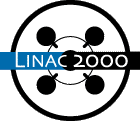
P. Bricault, G. Dutto, R. Poirier, A. Mitra, R. Laxdal, P. Schmor, G. Stanford (TRIUMF)
The first phase of the ISAC radioactive ion beam facility at TRIUMF is well under way. It combines an isotope mass separator-on-line with a post accelerator. Required in the accelerator chain is a drift tube LINAC capable of accelerating unstable nuclei with a charge to mass ratio greater or equal to 1/6 from E = 0.15 MeV/nucleon to a final energy fully variable up to 1.5 MeV/nucleon. Due to the relatively low intensities of some of the radioactive species, continuous (cw) operation of the accelerator is required. A five tank interdigital H-type structure, operating at 106 MHz, has been chosen. A separated function DTL concept has been developed[1]. Five independently phased IH tanks operating at synchronous phase equal 0 degree provide the main acceleration. Longitudinal focussing is provided by split-ring resonator structures[2] positioned before the second, third and fourth IH tanks. Quadrupole triplets placed after each IH tank maintain transverse focussing. Following the successful power test on the first tank the design and fabrication of the other four DTL tanks has been pursued. The whole DTL, rebunchers and quadrupole triplets are mounted on a large frame support to assure the best possible mechanical stability. Each component has an off axis alignment fixture to assure and maintain the alignment of the entire system.
[1] R.E. Laxdal, P. G. Bricault, T. Reis, 'A Separated Function DrifT-Tube LINAC for the ISAC Project at TRIUMF', Proc. of the 1997 Particle Accelerator Conference, Vancouver, p. 1196
[2] Y. Bylinsky, et al. 'A Triple Gap Resonator Design for the Separated Function DTL at TRIUMF', Proc. of the 1997 Particle Accelerator Conference, Vancouver.
Comments or Questions to
linac2000@slac.stanford.edu